Parse failure for https://anti-empire.com/feed/. Last Retry Monday January 05, 2026 07:21
Indymedia Ireland is a volunteer-run non-commercial open publishing website for local and international news, opinion & analysis, press releases and events. Its main objective is to enable the public to participate in reporting and analysis of the news and other important events and aspects of our daily lives and thereby give a voice to people.
 Fraud and mismanagement at University College Cork Thu Aug 28, 2025 18:30 | Calli Morganite Fraud and mismanagement at University College Cork Thu Aug 28, 2025 18:30 | Calli Morganite
UCC has paid huge sums to a criminal professor
This story is not for republication. I bear responsibility for the things I write. I have read the guidelines and understand that I must not write anything untrue, and I won't.
This is a public interest story about a complete failure of governance and management at UCC.
 Deliberate Design Flaw In ChatGPT-5 Sun Aug 17, 2025 08:04 | Mind Agent Deliberate Design Flaw In ChatGPT-5 Sun Aug 17, 2025 08:04 | Mind Agent
Socratic Dialog Between ChatGPT-5 and Mind Agent Reveals Fatal and Deliberate 'Design by Construction' Flaw
This design flaw in ChatGPT-5's default epistemic mode subverts what the much touted ChatGPT-5 can do... so long as the flaw is not tickled, any usage should be fine---The epistemological question is: how would anyone in the public, includes you reading this (since no one is all knowing), in an unfamiliar domain know whether or not the flaw has been tickled when seeking information or understanding of a domain without prior knowledge of that domain???!
This analysis is a pretty unique and significant contribution to the space of empirical evaluation of LLMs that exist in AI public world... at least thus far, as far as I am aware! For what it's worth--as if anyone in the ChatGPT universe cares as they pile up on using the "PhD level scholar in your pocket".
According to GPT-5, and according to my tests, this flaw exists in all LLMs... What is revealing is the deduction GPT-5 made: Why ?design choice? starts looking like ?deliberate flaw?.
People are paying $200 a month to not just ChatGPT, but all major LLMs have similar Pro pricing! I bet they, like the normal user of free ChatGPT, stay in LLM's default mode where the flaw manifests itself. As it did in this evaluation.
 AI Reach: Gemini Reasoning Question of God Sat Aug 02, 2025 20:00 | Mind Agent AI Reach: Gemini Reasoning Question of God Sat Aug 02, 2025 20:00 | Mind Agent
Evaluating Semantic Reasoning Capability of AI Chatbot on Ontologically Deep Abstract (bias neutral) Thought
I have been evaluating AI Chatbot agents for their epistemic limits over the past two months, and have tested all major AI Agents, ChatGPT, Grok, Claude, Perplexity, and DeepSeek, for their epistemic limits and their negative impact as information gate-keepers.... Today I decided to test for how AI could be the boon for humanity in other positive areas, such as in completely abstract realms, such as metaphysical thought. Meaning, I wanted to test the LLMs for Positives beyond what most researchers benchmark these for, or have expressed in the approx. 2500 Turing tests in Humanity?s Last Exam.. And I chose as my first candidate, Google DeepMind's Gemini as I had not evaluated it before on anything.
 Israeli Human Rights Group B'Tselem finally Admits It is Genocide releasing Our Genocide report Fri Aug 01, 2025 23:54 | 1 of indy Israeli Human Rights Group B'Tselem finally Admits It is Genocide releasing Our Genocide report Fri Aug 01, 2025 23:54 | 1 of indy
We have all known it for over 2 years that it is a genocide in Gaza
Israeli human rights group B'Tselem has finally admitted what everyone else outside Israel has known for two years is that the Israeli state is carrying out a genocide in Gaza
Western governments like the USA are complicit in it as they have been supplying the huge bombs and missiles used by Israel and dropped on innocent civilians in Gaza. One phone call from the USA regime could have ended it at any point. However many other countries are complicity with their tacit approval and neighboring Arab countries have been pretty spinless too in their support
With the release of this report titled: Our Genocide -there is a good chance this will make it okay for more people within Israel itself to speak out and do something about it despite the fact that many there are actually in support of the Gaza
 China?s CITY WIDE CASH SEIZURES Begin ? ATMs Frozen, Digital Yuan FORCED Overnight Wed Jul 30, 2025 21:40 | 1 of indy China?s CITY WIDE CASH SEIZURES Begin ? ATMs Frozen, Digital Yuan FORCED Overnight Wed Jul 30, 2025 21:40 | 1 of indy
This story is unverified but it is very instructive of what will happen when cash is removed
THIS STORY IS UNVERIFIED BUT PLEASE WATCH THE VIDEO OR READ THE TRANSCRIPT AS IT GIVES AN VERY GOOD IDEA OF WHAT A CASHLESS SOCIETY WILL LOOK LIKE. And it ain't pretty
A single video report has come out of China claiming China's biggest cities are now cashless, not by choice, but by force. The report goes on to claim ATMs have gone dark, vaults are being emptied. And overnight (July 20 into 21), the digital yuan is the only currency allowed. The Saker >>
Interested in maladministration. Estd. 2005
 RTEs Sarah McInerney ? Fianna Fail?supporter? Anthony RTEs Sarah McInerney ? Fianna Fail?supporter? Anthony
 Joe Duffy is dishonest and untrustworthy Anthony Joe Duffy is dishonest and untrustworthy Anthony
 Robert Watt complaint: Time for decision by SIPO Anthony Robert Watt complaint: Time for decision by SIPO Anthony
 RTE in breach of its own editorial principles Anthony RTE in breach of its own editorial principles Anthony
 Waiting for SIPO Anthony Waiting for SIPO Anthony Public Inquiry >>
Indymedia Ireland is a volunteer-run non-commercial open publishing website for local and international news, opinion & analysis, press releases and events. Its main objective is to enable the public to participate in reporting and analysis of the news and other important events and aspects of our daily lives and thereby give a voice to people.
 Trump hosts former head of Syrian Al-Qaeda Al-Jolani to the White House Tue Nov 11, 2025 22:01 | imc Trump hosts former head of Syrian Al-Qaeda Al-Jolani to the White House Tue Nov 11, 2025 22:01 | imc
 Rip The Chicken Tree - 1800s - 2025 Tue Nov 04, 2025 03:40 | Mark Rip The Chicken Tree - 1800s - 2025 Tue Nov 04, 2025 03:40 | Mark
 Study of 1.7 Million Children: Heart Damage Only Found in Covid-Vaxxed Kids Sat Nov 01, 2025 00:44 | imc Study of 1.7 Million Children: Heart Damage Only Found in Covid-Vaxxed Kids Sat Nov 01, 2025 00:44 | imc
 The Golden Haro Fri Oct 31, 2025 12:39 | Paul Ryan The Golden Haro Fri Oct 31, 2025 12:39 | Paul Ryan
 Top Scientists Confirm Covid Shots Cause Heart Attacks in Children Sun Oct 05, 2025 21:31 | imc Top Scientists Confirm Covid Shots Cause Heart Attacks in Children Sun Oct 05, 2025 21:31 | imc Human Rights in Ireland >>
|
Redrawing the Cultural Cityscape:
 national |
history and heritage |
opinion/analysis national |
history and heritage |
opinion/analysis
 Thursday June 18, 2020 17:19 Thursday June 18, 2020 17:19 by Caoimhghin Ó Croidheáin - Artist / Writer by Caoimhghin Ó Croidheáin - Artist / Writer

The Destiny of Colonial Monuments in Ireland
"Symbols are what unite and divide people. Symbols give us our identity, our self-image,our way of explaining ourselves to others. Symbols in turn determine the kinds of stories we tell; and the stories we tell determine the kind of history we make and remake."
Mary Robinson, Inauguration speech as President of Ireland, December 3, 1990
Introduction
On the night of the 8 March 1966 a massive explosion was heard in the centre of Dublin and Nelson's Pillar came crashing to the ground in hundreds of tons of rubble. No one was hurt and a stump was all that could be seen of the 157 year old monument. It was not the first time that monuments had been attacked in Ireland and certainly not the last, at least figuratively, with a series of later monuments accruing many derogatory nicknames from the Dublin people.
The recent spate of attacks on monuments in the US and the Uk has opened up the debate on the cultural issues they provoke, ranging from those who can't believe the attacks hadn't happened sooner to those who see their destruction as mob vandalism.
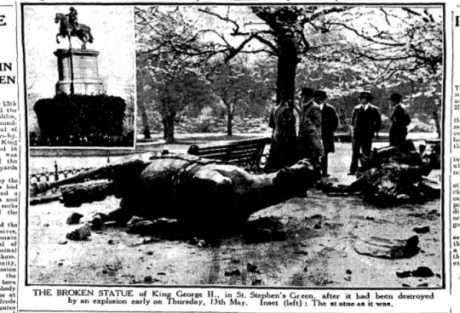 King George II equestrian monument Here, as everywhere, the public sphere is a highly contested one and not just culturally. For example, when the Irish Republic unilaterally declared independence in 1919, the Dáil Courts (Republican Courts) were set up, creating for the time being, a parallel (and popular) judicial system that frustrated the colonial power by undermining British rule in Ireland, and continued until independence.
Similarly the imposition of British cultural history in Ireland, through its monuments, was resented and these monuments became the focal point for the beginnings of a new public cultural space after independence. By wiping the slate clean, presumably it was thought, it would be possible to create a new progressive space based on Irish revolutionary figures. However, it did not quite work out like that. As in the political sphere, the public sphere remained a highly contested arena with successive conservative governments using different tactics to defer, reject or hinder progressive sculpture in Dublin.
I will look at the fate of some of these British historical monuments and the possibilities for future monuments that would more accurately reflect Irish peoples' historical struggles for freedom and independence.
'Removing' colonial history
William of Orange (1928)
In 1928 the statue of William of Orange (1701–1928) at College Green (in front of Trinity College) was damaged after an explosion on the anniversary of Armistice Day in 1928 and subsequently removed.
Donal Fallon quotes from the brief commentary on the statue that comes from a book, ‘Ireland In Pictures’, dating from 1898: "This equestrian statue of William II stands in College Green, and has stood there, more or less, since A.D 1701. We say “more or less” because no statue in the world, perhaps, has been subject to so many vicissitudes. It has been insulted, mutilated and blown up so many times, that the original figure, never particularly graceful, is now a battered wreck, pieced and patched together, like an old, worn out garment."
As historian Fin Dwyer writes: "If there was one statue that was not going to survive Irish independence this was it. William of Orange defeated James II at the battle of the Boyne in 1690 and ever since William and his victory has been twisted to suit political circumstances of the day. His victory had been celebrated by Unionists in the provactive 12th of July Parades in Ireland through the 19th century and he became a despised figure for Irish catholics and nationalists who saw William as a symbol of repression and discrimination. In 1929, the inevitable happened and the statue was blown up. Needless to say it wasn’t rebuilt."
'Young' Queen Victoria (1934)
According to Professor John A Murphy, UCC: "In August 1849, Queen Victoria witnessed her statue being hoisted on the highest gable of the new Queen’s College, now University College Cork. There it remained until 1934 when it was taken down and replaced by Finbarr, Cork’s patron saint. The Victoria statue was put in storage for some years and then bizarrely buried in what was admittedly UCC’s classiest location, the President’s Garden."
King George II (1937)
This equestrian monument of King George II in St Stephen's Green (1758–1937) was blown up on 13 May 1937, the day after the coronation of George VI. It was unveiled in 1758 and depicted George II in Roman attire. It was placed on a tall pedestal but still 'the victim of many attacks'.
'Old' Queen Victoria (1948)
The statue of Queen Victoria at Leinster House, Kildare Street (1904–1948) was removed in 1948 as part of moves by the Irish State towards declaring a Republic, and eventually shipped to Sydney, Australia in 1987 where it is now on display on the corner of Druitt and George Street in front of the Queen Victoria Building.
The anger towards British colonialism in Ireland could be seen in newspaper reports of the time, for example:
"In 1895, The Nation newspaper noted that Irish migrants in New York had celebrated Victoria’s Jubilee with “the most appropriate celebration”, staging demonstrations and distributing political literature to highlight their view that: "some of the benefits conferred upon Ireland during Victoria’s murderous reign: Died of famine 1,500,000; evicted 3,668,000; expatriated 4,200,000; emigrants who died of ship fever, 57,000; imprisoned under the Coercion Acts, over 3,000; butchered in suppressed public meetings, 300; Coercion Acts, 53; executed for resisting tyranny, 95; died in English dungeons, 270; newspapers suppressed, 12."
George Howard (1956)
The statue of George Howard (Earl of Carlisle) in the Phoenix Park (1870–1956) was blown off its plinth in an explosion in 1956 and moved to Castle Howard in Yorkshire. The pedestal remains in place as a memorial. George Howard (1802–1864), the 7th Earl of Carlisle, served under Lord Melbourne as Chief Secretary for Ireland between 1835 and 1841.
Gough Monument (1957)
The Gough Monument in the Phoenix Park (1880–1957) was blown up in 1957, it was later restored and re-erected in the grounds of Chillingham Castle, England, in 1990. Field Marshal Hugh Gough, 1st Viscount Gough (1779–1869) was a British Army officer born at Woodstown, Annacotty, Ireland. Gough's colonial credentials are impeccable, serving British forces in China, India and South Africa where he "commanded the 2nd Battalion of the 87th (Royal Irish Fusiliers) Regiment of Foot during the Peninsular War. After serving as commander-in-chief of the British forces in China during the First Opium War, he became Commander-in-Chief, India and led the British forces in action against the Marathas defeating them decisively at the conclusion of the Gwalior Campaign and then commanded the troops that defeated the Sikhs during both the First Anglo-Sikh War and the Second Anglo-Sikh War."
The attack on the Gough Monument demonstrated that being Irish-born was no guarantee of immunity from denunciation and execration. Indeed, the assaults on colonial monuments also became a subject for Irish writers over subsequent decades too. The well-known Irish writer, Myles na gCopaleen, commented on a previous attack on the Gough monument when it was beheaded on Christmas Eve 1944. Writing in his column, Cruiskeen Lawn in The Irish Times in January 1945, he commented:
"Few people will sympathise with this activity; some think it is simply wrong, others do not understand how anybody could think of getting up in the middle of a frosty night in order to saw the head of a metal statue. [...] The Gough statue in question was a monstrosity, famous only for the disproportion of the horse’s legs, its present headlessness gives it a grim humour and even if the head is recovered, I urge strongly that no attempt should be made to solder it on."
The head was eventually found in the River Liffey, the main river running through the centre of Dublin. The fate of the Gough statue is also known because of a poem believed to have been written by another Irish writer, Brendan Behan (though some attribute it to poet Vincent Caprani):
"Neath the horse’s prick, a dynamite stick
Some Gallant hero did place
For the cause of our land, with a light in his hand
Bravely the foe he did face.
Then without showing fear, he kept himself clear
Excepting to blow up the pair
But he nearly went crackers, all he got was the knackers
And made the poor stallion a mare."
Nelson's Pillar (1966)
Nelson's Pillar O'Connell Street (1809–1966) was blown up in 1966 on the 50th anniversary of the 1916 Rising. The head of Nelson's statue was rescued, and is currently on display in the Dublin City Library and Archive on Pearse Street. Vice-Admiral Horatio Nelson (1758–1805) was a British flag officer in the Royal Navy. His naval victories around Europe, Egypt and the Canaries brought him much fame in Britain and an early death at the age of 47. The remaining stump was blown up by the Irish army to the delight of gathered Dubliners who according to the press "raised a resounding cheer".
The destruction of the pillar soon became the subject of two songs which both went into the Irish charts. The first called "Nelson's Farewell" was the first single by The Dubliners and was released in 1966 on the label Transatlantic Records. The gist of the song was that because of the explosion, Nelson, atop the pillar, had been launched into space:
"Oh the Russians and the Yanks, with lunar probes they play
Toora, loora, loora, loora, loo
And I hear the French are trying hard to make up lost headway
Toora, loora, loora, loora, loo
But now the Irish join the race, we have an astronaut in space
Ireland, boys, is now a world power too"
The other song was called "Up Went Nelson", "set to the tune of "John Brown's Body" and performed by a group of Belfast schoolteachers, which remained at the top of the Irish charts for eight weeks":
"One early mornin' in the year of '66
A band of Irish laddies were knockin' up some tricks
They though Horatio Nelson had overstayed a mite
So they helped him on his way with some sticks of gelignite"
Conclusion
Despite the regularly re-engineered cityscape of Dublin, the way was not cleared for a spate of representations of Irish national heroes. What was erected tended to be mythologisations of Irish history (the Children of Lir in the Garden of Remembrance, Cú Chulainn in the GPO: see my 1916 article) as if Irish elites feared the posthumous visages of its bravest and the effect their presence might have on the Dublin populace. What revolutionary figures that do exist in statue form (Tone, Emmett, Connolly etc) tend to be tucked away in parks or on side streets while the main bourgeois nationalist heroes stand on large plinths on Dublin's main streets (O'Connell, Parnell etc).
The lack of a major monument on a major street in Dublin commemorating, for example, the Great Hunger or the Seven Signatories of the 1916 Proclamation shows that, despite the decades of resistance to an imposed history, we are still not allowed to commemorate our own.
Caoimhghin Ó Croidheáin is an Irish artist, lecturer and writer. His artwork consists of paintings based on contemporary geopolitical themes as well as Irish history and cityscapes of Dublin. His blog of critical writing based on cinema, art and politics along with research on a database of Realist and Social Realist art from around the world can be viewed country by country here. He is a Research Associate of the Centre for Research on Globalization.
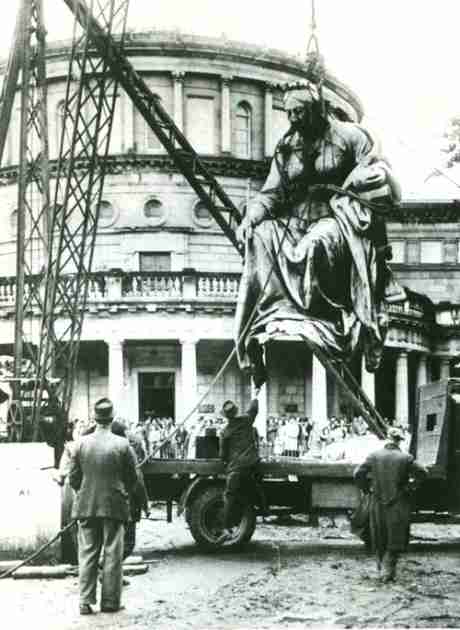
Statue of Queen Victoria
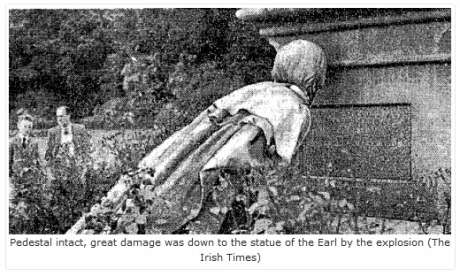
Carlisle statue
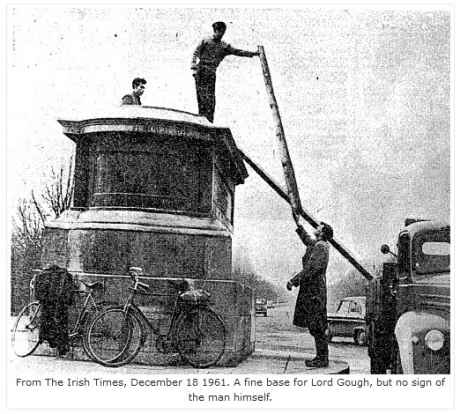
Gough Monument
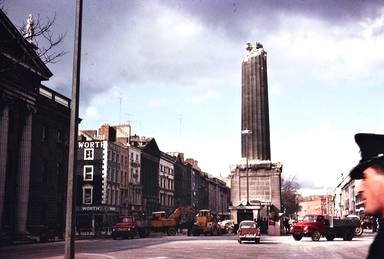
Nelson's Pillar
|
 national |
history and heritage |
opinion/analysis
national |
history and heritage |
opinion/analysis
 Thursday June 18, 2020 17:19
Thursday June 18, 2020 17:19 by Caoimhghin Ó Croidheáin - Artist / Writer
by Caoimhghin Ó Croidheáin - Artist / Writer





























 printable version
printable version

 Digg this
Digg this del.icio.us
del.icio.us Furl
Furl Reddit
Reddit Technorati
Technorati Facebook
Facebook Gab
Gab Twitter
Twitter